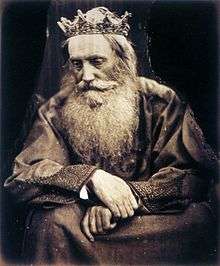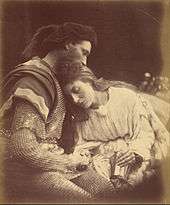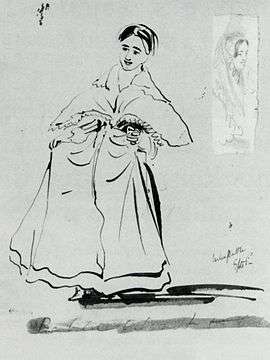Julia Margaret Cameron
| Julia Margaret Cameron | |
|---|---|
 Painting of Julia Margaret Cameron by George Frederic Watts, c. 1850–1852 | |
| Born |
Julia Margaret Pattle 11 June 1815 Calcutta, British India |
| Died |
26 January 1879 (aged 63) Kalutara, British Ceylon |
| Nationality | British |
| Known for | Photography |
Julia Margaret Cameron (née Pattle; 11 June 1815 Calcutta – 26 January 1879 Kalutara, Ceylon) was a British photographer.[1] She became known for her portraits of celebrities of the time, and for photographs with Arthurian and other legendary or heroic themes.
Cameron's photographic career was short, spanning eleven years of her life (1864–1875). She took up photography at the relatively late age of 48, when she was given a camera as a present.[2] Her style was not widely appreciated in her own day: her choice to use a soft focus and to treat photography as an art as well as a science, by manipulating the wet collodion process, caused her works to be viewed as "slovenly", "mistakes" and bad photography. She found more acceptance among pre-Raphaelite artists than among photographers.[3] Her work has influenced modern photographers, especially her closely cropped portraits. Her house, Dimbola Lodge, on the Isle of Wight is open to the public.
Early life
Julia Margaret Cameron was born Julia Margaret Pattle in Calcutta, India, to Adeline de l'Etang and James Pattle, a British official of the East India Company. Adeline de l'Etang was the daughter of Chevalier Antoine de l'Etang, who had been a page of Marie Antoinette as well as an officer in the Garde du Corps of King Louis XVI. He had married the Indian-born Therese Blin de Grincourt, a daughter of French aristocrats.[4]
Cameron was from a family of celebrated beauties and was considered an ugly duckling among her sisters. As her great-niece Virginia Woolf wrote in the 1926 introduction to the Hogarth Press collection of Cameron's photographs, "In the trio [of sisters] where...[one] was Beauty; and [one] Dash; Mrs. Cameron was undoubtedly Talent".[5] Cameron's sister Virginia was the mother of the temperance leader Lady Henry Somerset.

.jpg)



Marriage
Cameron was educated in France, but returned to India, and in 1838 married Charles Hay Cameron, a jurist and member of the Law Commission stationed in Calcutta, who was twenty years her senior. They had five children together, and also raised five young relations and an Irish girl called Mary Ryan whom Cameron found begging in England.[6]
In 1848, Charles Hay Cameron retired, and the family moved to London, England. Cameron's sister, Sarah Prinsep, had been living in London and hosted a salon at Little Holland House, the dower house of Holland House in Kensington, where famous artists and writers regularly visited. In 1860, Cameron visited the estate of poet Alfred Lord Tennyson on the Isle of Wight. Cameron was taken with the location, and the Cameron family purchased a property on the island soon after. They called it Dimbola Lodge after the family's Ceylon estate.
Photography
In 1863, when Cameron was 48 years old, her daughter gave her a camera as a present, thereby starting her career as a photographer. Within a year, Cameron became a member of the Photographic Societies of London and Scotland. She remained a member of the Photographic Society, London, until her death.[7] In her photography, Cameron strove to capture beauty. She wrote, "I longed to arrest all the beauty that came before me and at length the longing has been satisfied."[8][9]
.jpg)
The basic techniques of soft-focus "fancy portraits", which she later developed, were taught to her by David Wilkie Wynfield. She later wrote that "to my feeling about his beautiful photography I owed all my attempts and indeed consequently all my success".[10]
Lord Tennyson, her neighbour on the Isle of Wight, often brought friends to see the photographer and her works.
At the time, photography was a labour-intensive art that also was highly dependent upon crucial timing. Sometimes Cameron was obsessive about her new occupation, with subjects sitting for countless exposures in the blinding light as she laboriously coated, exposed, and processed each wet plate. The results were, in fact, unconventional in their intimacy and their particular visual habit of created blur through both long exposures, where the subject moved, and leaving the lens intentionally out of focus. Other photographers strove for vastly different applications. This led some of her contemporaries to complain and even ridicule the work, but her friends and family were supportive, and she was one of the most prolific and advanced of amateurs in her time. Her enthusiasm for her craft meant that her children and others sometimes tired of her endless photographing, but it also left us with some of the best of records of her children and of the many notable figures of the time who visited her.
During her career, Cameron registered each of her photographs with the copyright office and kept detailed records. Her shrewd business sense is one reason that so many of her works survive today. Another reason that many of Cameron's portraits are significant is because they are often the only existing photograph of historical figures, becoming an invaluable resource. Many paintings and drawings exist, but, at the time, photography was still a new and challenging medium for someone outside a typical portrait studio.
The bulk of Cameron's photographs fit into two categories—closely framed portraits and illustrative allegories based on religious and literary works. In the allegorical works in particular, her artistic influence was clearly Pre-Raphaelite, with far-away looks, limp poses, and soft lighting.[11]
Portraits

Cameron's sister ran the artistic scene at Little Holland House, which gave her many famous subjects for her portraits. Some of her famous subjects include: Charles Darwin, Alfred Lord Tennyson, Robert Browning, John Everett Millais, William Michael Rossetti, Edward Burne-Jones, Ellen Terry, and George Frederic Watts. Most of these distinctive portraits are cropped closely around the subject's face and are in soft focus. Often Cameron was a friend of these Victorian celebrities, and, knowing them well, tried to capture their personalities in her photographs. Among Cameron's lesser-known images are those she took of Mary Emily ('May') Prinsep, wife of Hallam Tennyson, 2nd Baron Tennyson, the elder son of Alfred Tennyson and a British colonial administrator. Cameron's portraits of May Prinsep, taken on the Isle of Wight, show a somewhat plain woman shot head-on and without affect.[12] May also sat for photographs that fall into the second major division of Cameron's works.
Photographic illustrations

Cameron's posed photographic illustrations represent the other half of her work. In these illustrations, she frequently photographed historical scenes or characters drawn from literary works, which often took the quality of oil paintings. She made no attempt, however, to hide the backgrounds. Cameron's friendship with Tennyson led to him asking her to photograph illustrations for his Idylls of the King. These photographs are designed to resemble oil paintings from the same time period, including rich details such as historical costumes and intricate draperies. Today, these posed works are sometimes dismissed by art critics. Nevertheless, Cameron saw these photographs as art, comparable to the oil paintings they imitated.
Cameron posed May Prinsep (Hallam Tennyson's wife) to model as Beatrice Cenci in an 1866 albumen print portrait among a series she devoted to Cenci, illustrating a heroic legend developed in Rome when Cenci was executed for killing her brutal father who abused her and other members of their family.

Later life
In 1875, the Camerons moved back to Ceylon (now Sri Lanka). Cameron continued to practise photography, but she complained in letters about the difficulties of getting chemicals and pure water to develop and print photographs. Also, in Ceylon, she did not have access to the Little Holland House salon's artistic community for subjects. She also did not have a market to distribute her photographs as she had in England. Because of this, Cameron took fewer images in Ceylon. Those she did were of posed Ceylonese people, paralleling the posed pictures that Cameron had taken of neighbours in England. Almost none of Cameron's work from Ceylon survives.
Cameron died while in Ceylon. Her death is attributed to having caught a bad chill and she died in Kalutara, Ceylon in 1879.
Legacy

Cameron's niece Julia Prinsep Stephen (née Jackson; 1846–1895) wrote the biography of Cameron that appeared in the first edition of the Dictionary of National Biography, 1886.[13] Julia Stephen was the mother of Virginia Woolf, who wrote a comic portrayal of the "Freshwater circle" in her only play Freshwater. Woolf, in collaboration with Roger Fry, edited a collection of Cameron's photographs that was published in 1926.[14]
It was not until 1948, however, that Cameron's photography became more widely known. At that time Helmut Gernsheim wrote a book on her work.[15] In 1977 Gernsheim noted that although a great photographer, Cameron had "left no mark" on the aesthetic history of photography because her work was not appreciated by her contemporaries and thus not imitated.[16]
Evidently since that time this situation has begun to change, thanks to his popularisation of her work. For instance in 1975 Imogen Cunningham had commented "I'd like to see portrait photography go right back to Julia Margaret Cameron. I don't think there's anyone better."[16]
In 2013, Getty Images noted in its caption of a portrait of Alice Liddell (whom Cameron photographed as Alethea, Pomona, Ceres, and St. Agnes in 1872) that "Cameron's photographic portraits are considered among the finest in the early history of photography".[17]
Also in 2013, the Metropolitan Museum of Art opened an exhibition of some representative examples of the photography of Cameron. Although only including limited numbers from her "copious" body of works, the exhibition garnered significant reviews.[18]
Often, Julia Margaret Cameron's work is discussed in relation to the portraiture of another upper-class British female photographer, Lady Clementina Hawarden.
An exhibition of more than 100 of Cameron's works was held in the Art Gallery of New South Wales in 2015, one of three exhibitions from the collections of the Victoria and Albert Museum touring Australia at the time. Critic John McDonald wrote that Cameron's pictures of women and girls are "her most original contributions to photography".[19]
Exhibitions
This is an incomplete list of major exhibitions dedicated to Cameron. The listing is ordered by date.
| Title | Dates | Location |
|---|---|---|
| Whisper of the Muse[20] | September 10, 1986 – November 16, 1986 | Getty Villa, United States |
| Whisper of the Muse at Loyola Marymount University[21] | September 12, 1986 – October 25, 1986 | Laband Gallery, United States |
| Portrait Photographs by Julia Margaret Cameron[21] | November 25, 1987 – February 14, 1988 | National Portrait Gallery, United States |
| Julia Margaret Cameron: The Creative Process[21] | October 15, 1996 – January 5, 1997 | Getty Villa, United States |
| Julia Margaret Cameron: The Creative Process[21] | February 4, 1998-May 3, 1998 | Art Gallery of Ontario, Canada |
| Julia Margaret Cameron[22] | February 6, 2003 – May 26, 2003 | National Portrait Gallery, United Kingdom |
| Julia Margaret Cameron: Nineteenth Century Photographic Genius[21] | June 5, 2003 – August 30, 2003 | National Media Museum, United Kingdom |
| Julia Margaret Cameron, Photographer[23] | October 21, 2003 – January 11, 2004 | Getty Center, United States |
| Julia Margaret Cameron[24] | August 19, 2013 – January 5, 2014 | Metropolitan Museum of Art, United States |
| Julia Margaret Cameron[25] | August 15, 2015 – October 25, 2015 | Art Gallery of New South Wales, Australia |
| Julia Margaret Cameron: Influence and Intimacy[26] | September 24, 2015 – March 28, 2016 | Science Museum, United Kingdom |
| Julia Margaret Cameron[27] | November 28, 2015 – February 21, 2016 | Victoria and Albert, United Kingdom |
| Julia Margaret Cameron: A Woman who Breathed Life into Photographs[28] | July 2, 2016 – September 19, 2016 | Mitsubishi Ichigokan Museum, Japan |
Portraits of Julia Margaret Cameron
There are seven known portraits of Julia Margaret Cameron. The best examples of these are held by the National Portrait Gallery in England.
 Painting by George Frederic Watts - 1850-1852
Painting by George Frederic Watts - 1850-1852 Photograph by her brother-in-law Charles Somers Somers-Cocks, 3rd Earl Somers, c. 1860
Photograph by her brother-in-law Charles Somers Somers-Cocks, 3rd Earl Somers, c. 1860 Portrait by Henry Herschel Hay Cameron - 1870
Portrait by Henry Herschel Hay Cameron - 1870 Portrait by Henry Herschel Hay Cameron - 1870
Portrait by Henry Herschel Hay Cameron - 1870 Drawing of Julia Margaret Cameron by James Prinsep (Date Unknown)
Drawing of Julia Margaret Cameron by James Prinsep (Date Unknown)
Bibliography
- Cameron, J. M. P. (1875). Illustrations by Julia Margaret Cameron of Alfred Tennyson's Idylls of the King and other poems
- Cameron, J. M. P. (1889). Unfinished autobiography "Annals of my glass house" by Julia Margaret Cameron, written 1874, first published 1889
- Cameron, J. M. P. (1973). Victorian photographs of famous men & fair women. Boston: D.R. Godine
- Cameron, J. M. (1975). The Herschel album: an album of photographs. London (2 St Martin's Place, WC2H 0HE): National Portrait Gallery
- Cameron, J. M., & Ford, C. (1975). The Cameron Collection: an album of photographs. Wokingham: Van Nostrand Reinhold for the National Portrait Gallery
- Cameron, J. M. P., & Weaver, M. (1986). Whisper of the muse: the Overstone album & other photographs. Malibu: J. Paul Getty Museum
- Cameron, J. M. P. (1994). For my best beloved sister, Mia: an album of photographs by Julia Margaret Cameron : an exhibition of works from the Hochberg-Mattis collection organized by the University of New Mexico Art Museum. Albuquerque: University of New Mexico Art Museum
References
- ↑ Crompton, Sarah (6 May 2016). "She takes a good picture: six forgotten female pioneers of photography". London: The Guardian. Retrieved 9 May 2016.
- ↑ J. Paul Getty Museum. Julia Margaret Cameron. Retrieved 13 September 2008.
- ↑ Ruggeri, Amanda (12 January 2016). "When mistakes make the art". BBC. Retrieved 23 January 2016.
- ↑ The Intersecting Realities and Fictions of Virginia Woolf and Colette – Helen Southworth – Google Boeken. Books.google.com. Retrieved 1 August 2013.
- ↑ Setina, Emily. A Camera of Her Own: Woolf and the Legacy of the Indomitable Mrs. Cameron. Literature Compass 4/1(2007):263–270.
- ↑ Higgins, Charlotte (22 September 2015). "Julia Margaret Cameron: soft-focus photographer with an iron will". The Guardian. Retrieved 25 July 2016.
- ↑ "Members of the Royal Photographic Society, 1853–1901". The Royal Photographic Society. 2013. Retrieved 27 October 2015.
- ↑ AskOxford: The Cod and the Camera Quote is taken from her unpublished autobiography, "Annals of My Glass House."
- ↑ Cox, Julian; Ford, Colin (2002). Julia Margaret Cameron, the complete photographs. Los Angeles: Getty Publications. p. 175.
- ↑ "Victoria and Albert Museum: Julia Margaret Cameron Related Photographers". Vam.ac.uk. 2013-08-19. Retrieved 2014-03-02.
- ↑ Rosenblum, Naomi. A History of Women Photographers. Third ed. New York: Abbeville Press Publishers, 2010. p. 52.
- ↑ 'Christabel' Mary Prinsep images at the National Portrait Gallery, London.
- ↑ Stephen, L. (1886). Dictionary of national biography: vol. VIII. Burton – Cantwell. London: Smith, Elder, & Co.
- ↑ Woolf, V., & Fry, R. E. (1926). Victorian photographs of famous men & women. New York: Harcourt, Brace.
- ↑ Gernsheim, H. (1948). Julia Margaret Cameron; her life and photographic work. Famous photographers. London: Fountain Press; distributed in the USA by Transatlantic Arts, New York.
- 1 2 Dialogue With Photography by Paul Hill & Thomas Cooper, Thames & Hudson 1979
- ↑ "Photograph by Julia Margaret Cameron of Alice Liddell: Getty Images #90762993". Getty Images. Retrieved 5 March 2013.
- ↑ Lane, Anthony, Names and Faces, the portraits of Julia Margaret Cameron, The New Yorker, 2 September 2013, pages 69–73.
- ↑ McDonald, John (26 September 2015). "Julia Margaret Cameron". The Sydney Morning Herald. Retrieved 27 October 2015.
- ↑ Cameron, Julia Margaret; Howard, Jeremy (1990). Whisper of the muse : the world of Julia Margaret Cameron. London: Colnaghi. ISBN 978-0892360888.
- 1 2 3 4 5 "The Whisper of the Muse / Portrait of G.F. Watts". The J. Paul Getty Museum. Retrieved 29 November 2015.
- ↑ "Julia Margaret Cameron". National Portrait Gallery. Retrieved 29 November 2015.
- ↑ "Julia Margaret Cameron, Photographer". The J. Paul Getty Museum. Retrieved 29 November 2015.
- ↑ "Julia Margaret Cameron". The Metropolital Museum of Art. Retrieved 29 November 2015.
- ↑ "Julia Margaret Cameron". Art Gallery of New South Wales. Retrieved 29 November 2015.
- ↑ "Julia Margaret Cameron: Influence and Intimacy". Science Museum. Retrieved 29 November 2015.
- ↑ "Julia Margaret Cameron". Victoria and Albert Museum. Retrieved 29 November 2015.
- ↑ "Julia Margaret Cameron: A Woman who Breathed Life into Photographs". Mitsubishi Ichigokan Museum. Retrieved 31 July 2016.
Further reading
- Cox, Julian, and Colin Ford (2003). Julia Margaret Cameron: the complete photographs. Los Angeles: Getty Publications
- Douglas-Fairhurst, Robert (January 2016). "The Taker of Chances". Apollo. 183 (638): 48–54.
- Lukitsh, Joanne (2001). Julia Margaret Cameron. London: Phaidon
- Wolf, Sylvia, et al. (1998). Julia Margaret Cameron's women. Chicago: Art Institute of Chicago
- Rosen, Jeff (2016). Julia Margaret Cameron's 'Fancy Subjects'. Manchester University Press
External links
- Finding Aid for Julia Margaret Cameron family papers at the Getty Research Institute
 Media related to Julia Margaret Cameron at Wikimedia Commons
Media related to Julia Margaret Cameron at Wikimedia Commons